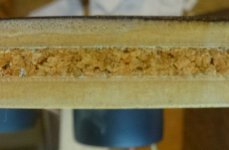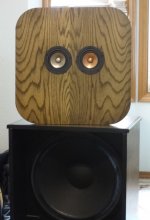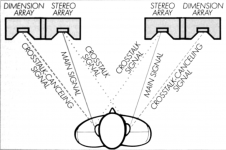This thread is for my "Use Your Illusion, II" OB design, combining OB with Polk's SDA driver arrangement.
As we know, Stereo itself is an illusion and a pretty good one. Dipole effects from an OB (or other arrangement) casts, IMHO, a wonderful 3D "soundstage" where the out of phase backwave is contributing. This design augments that effect with the "Stereo Dimensional Array" effect from adding two additional speakers in the typical Polk arrangement for doing that.
That arrangement involves something called the intra-aural distance, which is simply the distance between your ears. I measured the back of my skull with a caliper and came up with appx 5.5", which is the horizontal distance between the drivers in the SDA arrangement. So on each baffle plane there is the main speaker and to the outside of it, 5.5" away, the SDA speaker.
The electrical arrangement has the right SDA speaker running out of phase with the left main speaker - and vice versa. Because the drivers I used are 4 Ohm, I decided to connect them in series to avoid a 2 Ohm load on the amplifier. Speaker cabling consists of the usual pair from the amp to each speaker and a single pair running between them. However, to make the circuit I swapped grounds between the channels; each channel makes a loop from amp to speaker, to the other speaker and back. Each speaker cable pair carries L on one wire, R on the other. Unsure what this does "speaker cable effects" wise, but it's unlike any other.
I have an 8 Ohm non-inductive resistor across each of the SDA speakers, padding them down a bit, so the main OB speakers are somewhat prominent. Of course, reactive elements can be used as well, to change to frequency content on the SDA drivers; I've read where the SDA driver doesnt have to emit the full frequency spectrum. For simplicity at the outset, I'll leave them full range.
One acoustic trick I've implemented is enclosing the SDA drivers, to prevent rear-radiation from those. It's not clear to me if augmenting the rear radiation of the main driver with an opposite channel, out of phase signal is useful regarding the OB depth illusuon. It's certainly a factor to experiment with, for now I'm going to leave the SDA drivers enclosed. Of course, that enclosure type can be improved from what's shown here.
I made up a working mock-up out of scrap 24" square plywood shown in the pictures below. The drivers are Mark Audio, CHN50 and Alpair 5.2. Due to workmanship difficulties with the baffle cutouts, I ended up with the 50s as the main and the Alpairs as the SDAs. I left them to cross at ~200 to the bass drivers being a pair of H frames. (Part of the justification of getting to have these in the BR, is my wife gets to use the H frames as a platform for her flower and veggie starts in the spring. Done deal! So the bass changes some when I push them back toward the window...)
Their sound really is a true combination of the OB sound I'm used to plus the SDA fattening of the image width, such that it's no longer just between the inside edges of the baffles. The panels seem to respond to a deep amount of toe-in, regarding inside image focus. This to me suggest the SDA drivers need to lead a little in phase, relative to the main driver. Effects from the sloppy mock-up build seem to be the main drawback at this point; when you play loud, those thin plywood panels start to emit their own driver mounting conducted crud and I can hear it.
I've lots of material I can fix that issue with. Plenty of 1-3/16" MDF to make a couple higher mass panels or other shapes (barrel?) out
of. The machining of the driver cutouts such that the back of that Alpair 5.2 really radiates freely, while the front remains free and clear
also is challenging. It would be great to mount the Alpair to the baffle front plane, the CHN50 to the back plane of a 1+" board to get a little mechanical offset, but I'm having difficulty imagining the cutouts nevermind executing them. Example, what's the proven waveguide curve for the front of one of these small diameter drivers, the back of the other - that still allows screws to hold it fastened? Seems I'd have to make a tool to impart that curve, whatever it is...
Anyway, I find it a pleasant listen and so easy to do. Any inputs, encouragements, thoughts are most welcome!


As we know, Stereo itself is an illusion and a pretty good one. Dipole effects from an OB (or other arrangement) casts, IMHO, a wonderful 3D "soundstage" where the out of phase backwave is contributing. This design augments that effect with the "Stereo Dimensional Array" effect from adding two additional speakers in the typical Polk arrangement for doing that.
That arrangement involves something called the intra-aural distance, which is simply the distance between your ears. I measured the back of my skull with a caliper and came up with appx 5.5", which is the horizontal distance between the drivers in the SDA arrangement. So on each baffle plane there is the main speaker and to the outside of it, 5.5" away, the SDA speaker.
The electrical arrangement has the right SDA speaker running out of phase with the left main speaker - and vice versa. Because the drivers I used are 4 Ohm, I decided to connect them in series to avoid a 2 Ohm load on the amplifier. Speaker cabling consists of the usual pair from the amp to each speaker and a single pair running between them. However, to make the circuit I swapped grounds between the channels; each channel makes a loop from amp to speaker, to the other speaker and back. Each speaker cable pair carries L on one wire, R on the other. Unsure what this does "speaker cable effects" wise, but it's unlike any other.
I have an 8 Ohm non-inductive resistor across each of the SDA speakers, padding them down a bit, so the main OB speakers are somewhat prominent. Of course, reactive elements can be used as well, to change to frequency content on the SDA drivers; I've read where the SDA driver doesnt have to emit the full frequency spectrum. For simplicity at the outset, I'll leave them full range.
One acoustic trick I've implemented is enclosing the SDA drivers, to prevent rear-radiation from those. It's not clear to me if augmenting the rear radiation of the main driver with an opposite channel, out of phase signal is useful regarding the OB depth illusuon. It's certainly a factor to experiment with, for now I'm going to leave the SDA drivers enclosed. Of course, that enclosure type can be improved from what's shown here.
I made up a working mock-up out of scrap 24" square plywood shown in the pictures below. The drivers are Mark Audio, CHN50 and Alpair 5.2. Due to workmanship difficulties with the baffle cutouts, I ended up with the 50s as the main and the Alpairs as the SDAs. I left them to cross at ~200 to the bass drivers being a pair of H frames. (Part of the justification of getting to have these in the BR, is my wife gets to use the H frames as a platform for her flower and veggie starts in the spring. Done deal! So the bass changes some when I push them back toward the window...)
Their sound really is a true combination of the OB sound I'm used to plus the SDA fattening of the image width, such that it's no longer just between the inside edges of the baffles. The panels seem to respond to a deep amount of toe-in, regarding inside image focus. This to me suggest the SDA drivers need to lead a little in phase, relative to the main driver. Effects from the sloppy mock-up build seem to be the main drawback at this point; when you play loud, those thin plywood panels start to emit their own driver mounting conducted crud and I can hear it.
I've lots of material I can fix that issue with. Plenty of 1-3/16" MDF to make a couple higher mass panels or other shapes (barrel?) out
of. The machining of the driver cutouts such that the back of that Alpair 5.2 really radiates freely, while the front remains free and clear
also is challenging. It would be great to mount the Alpair to the baffle front plane, the CHN50 to the back plane of a 1+" board to get a little mechanical offset, but I'm having difficulty imagining the cutouts nevermind executing them. Example, what's the proven waveguide curve for the front of one of these small diameter drivers, the back of the other - that still allows screws to hold it fastened? Seems I'd have to make a tool to impart that curve, whatever it is...
Anyway, I find it a pleasant listen and so easy to do. Any inputs, encouragements, thoughts are most welcome!
Thanks Joe, I also hadn't seen this before and I've been hanging around audio long enough!
Using a second amplifier to drive the SDA speakers would simplify the wiring and allow a variable degree of effect to be tried.
I'm not sure how crtical that 5.5'' distance is as the geometry will be affected by the listening distance?
I'm tempted to try with 2 amps amps and 2 pairs of regular speakers - should give an indication of potential...
Using a second amplifier to drive the SDA speakers would simplify the wiring and allow a variable degree of effect to be tried.
I'm not sure how crtical that 5.5'' distance is as the geometry will be affected by the listening distance?
I'm tempted to try with 2 amps amps and 2 pairs of regular speakers - should give an indication of potential...
That is a very neat experiment. I own some SDAs and I always thought the inside speakers were the ones canceling the other cabinet. May just be my fuzzy memory, but it would not be difficult for you to swap your prototypes to put the effect driver on the inside. You have started me thinking, thank you
Last edited by a moderator:
That "inside" cancelers would be easy enough to try - just swap left and right panels. I did do an experiment with a set of "normal" speakers, disconnecting the tweeter on the cancelling pair. That provided enough of an effect for me to take it to this step.
I was thinking of running a dual L-Pad out to my chair, so I could dial up the signal to the cancelling pair from zero. The only one of those I have is inside my guitar amp, where I was using it as a power soak for small tube amps I used to make up for guitar.
There's another connection topology to try as well, amplifier + to + on each of the 2nd pair. Unsure how happy my class D amp would be with 2 Ohms + to +, but if it worked, it might impart an interesting effect; ambient info on the (inside / outside) set.
I was thinking of running a dual L-Pad out to my chair, so I could dial up the signal to the cancelling pair from zero. The only one of those I have is inside my guitar amp, where I was using it as a power soak for small tube amps I used to make up for guitar.
There's another connection topology to try as well, amplifier + to + on each of the 2nd pair. Unsure how happy my class D amp would be with 2 Ohms + to +, but if it worked, it might impart an interesting effect; ambient info on the (inside / outside) set.
Ahhhh, crosstalk cancellation........
On the left speaker, 1 of the full ranges is actually the right channel wired out of phase ?
And vice versa ?
On the left speaker, 1 of the full ranges is actually the right channel wired out of phase ?
And vice versa ?
I tried reversing the speakers so that the "Dimension Array" driver is on the inside. It works, of course. However I note that the same phasing applies to my ears; the "Dimension Array" drivers want to lead in phase slightly, for best focus in the soundstage. So I have the panels "toed out". Which looks weird.
What if you mounted the drivers on a small baffle, loosely mounted ( felt or foam? ) to the main baffle, both isolating the vibration from the drivers, and adding some damping effect to the main baffle? Is it similar to cross feed on headphones?
I'm just imagining my partner walking in as I'm using a calipers to measure the back of my skull....😀
The solution is to make a tin-foil hat, and measure that.I'm just imagining my partner walking in as I'm using a calipers to measure the back of my skull....
Glad you're here for some common sense advice.The solution is to make a tin-foil hat, and measure that.
Gosh these things take time. I'm listening to "V2" of this design. This time using Alpair 7 HDs, one set of which I obtained from another member. Also made up a set of panels using cork in a constrained layer, to reduce ringing in the center-spine supported panel. Have yet to get the rear cover over the back of the SDA driver, so it doesnt radiate as a dipole.




Yes, whoopsed on the name.Pluvia 7HD?
Just glued the conical back covers in place. Adhesive says 1 hour tack free, 3 days full cure. Probably be violating that one too! Still tacky...
How does the cork sandwich respond to the knuckle test ? I'm very interested in using this method myself, my previous efforts at dead cabinets haven't been as successful as I'd have liked.
- Home
- Loudspeakers
- Full Range
- The "Use Your Illusion, II" Speaker
